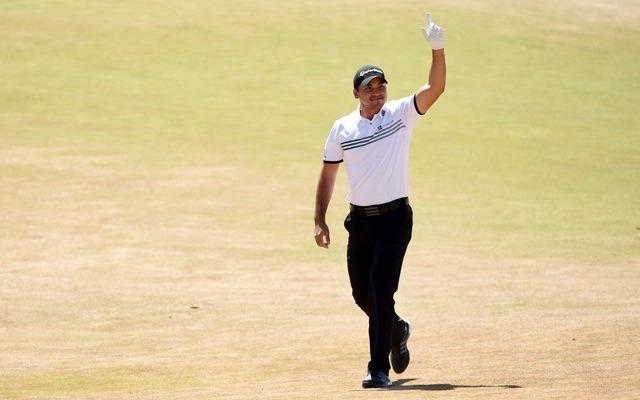
The 116th U.S. Open comes to us from the Oakmont Country Club in Pennsylvania. It’s a notoriously tough track; famous for its thick rough, lightning fast greens, and “church pew” bunkers. It’s a unique course with long par 5s, some short/some long par 4s, and even a 288-yard par 3! Despite being a par 70 at only 7,257 yards, it will play a little long. The fear of penal rough will force golfers to go with less than driver on a number of holes in hopes of keeping it in play. If you miss the fairway, you’re not hitting the green in regulation.
This is the ninth time Oakmont has hosted the U.S. Open, and I think we can learn a lot from the most recent results.
2007 U.S. Open Championship
1. Angel Cabrera +5
T-2. Jim Furyk +6
T-2. Tiger Woods +6
4. Niclas Fasth +7
T-5. David Toms +9
T-5. Bubba Watson +9
T-7. Nick Dougherty +10
T-7. Scott Verplank +10
T-7. Jerry Kelly +10
T-10. Justin Rose +11
T-10. Paul Casey +11
T-10. Stephen Ames +11
Full Results
The first thing that jumps out is the winning score: +5! So yeah… this course is tough. The next thing I noticed was how many names popped in the top-10 that were primarily accuracy players. Yes, Tiger Woods finished T-2, but it’s Tiger Woods. Bubba Watson’s in there, but he’s the rare bomber with an excellent short game. Furyk. Toms. Verplank. Kelly. Ames. Not exactly the longest hitters on tour. So while I think length will certainly be helpful this week, it’s not a priority for me.
*****PLAYER SELECTION*****
Let’s think about the setup for a second here, and that should give us a better idea of which golfers to target. First and foremost, you’re going to want accuracy off the tee. The fairways are narrow and finding the rough is a prison sentence. Those who keep it in play (thereby gaining strokes off the tee) will have a serious leg up on the competition.
- Target Driving Accuracy
- Target Strokes Gained: Off the Tee
But if the fairways are narrow it doesn’t matter who you are, you’re going to be spending some time in the rough. This isn’t the type of rough where things get a little more difficult, but pros can still usually find the green. It’s the type where on most occasions, these guys are going to be hacking it out and leaving themselves with a fair amount of distance remaining between them and the green. So what does that mean for our purposes?
- Target Scrambling
The greens are hard and fast, and you know the pins are going to be in some dastardly positions. The USGA’s vision for this course is to make it the next installment of the “Saw” movie franchise. They want carnage. They want golfers to look foolish. They do not want the winner to come in under par. So this tells us a few things. First (and though previously mentioned, it’s further solidified), these guys are going to be missing greens. Beyond that, it’s going to be very tough to get up and down. They’ll be dealing with thick rough and tricky bunkers around the green.
- Target Strokes Gained: Around the Green
- Target Bogey Avoidance
Even after they reach the green, the struggle is not over. It’s going to be like putting on ice. I’ve read some articles that suggest putting isn’t as important as a normal week, as even the best putters aren’t going to be making the 15-20 footers like they usually do. I mean, Webb Simpson and Lucas Glover are U.S. Open champions after all, how important can putting really be? The thing is, those two guys are elite ball strikers. If you can stay in the fairway and get the ball reasonably close to the pin in two, it probably doesn’t matter if you can’t putt. That said, I don’t really buy into the “greens are tough, so putting doesn’t matter” idea. Good putters will have more 1-putts and less 3-putts than the field. We’ll get into this more in a second, but the name of the game this week will be order of finish. If you can’t putt, you’re either going to have to lead the field in ball striking or you’re going to sink like a rock.
- Target Strokes Gained: Putting
With birdies few and far between, those place bonuses are going to be huge.
You want those 30 points. You need those 30 points. So I would recommend taking players you believe can win (or at least have a reasonable chance at a top-5). That previous sentence seems like the most obvious thing in the world, but I’ve seen a lot of talk this week about some older guys as well as some golfers of a lesser ilk. Just be careful there, as the worst thing you can do in the Millionaire Maker is roster someone who probably can’t finish top-5 AND is popular. There is literally zero upside in that scenario.
- Target Talent and Class
I think if you follow this general outline and work in a few of your own ideas, you should be good to go as far as player selection is concerned.
*****ROSTER CONSTRUCTION*****
With that out of the way, let’s spend a little time on roster construction. I’m going to specifically tailor this towards the Millionaire Maker. First, let’s take a look at the payouts.
Yikes. Depending on how you look at it, things get very good or very bad very quickly at the top. You can finish 26th out of 201,100 entries and still only take home $5,000. There are much better tournaments out there if your sole focus is making money. But… there are only four of these things a year, and for most of us, this is entertainment. We like the idea of a million dollars. So we’re going to play it. Personally, I know this tournament is crap, but it’s fun, and I can stand to lose the money I’m putting in play. I think it’s important to be aware of why you’re playing.
Now let’s degen…
The goal here is obviously to WIN. More specifically, it’s be the be sole winner. One of the worst things you could do in this particular tournament is throw in an entry that’s shared with 50 other players. If you do that, you’re capping your upside and really ignoring the whole reason to even play this thing. It’s called the “Millionaire Maker,” not the “Chop with 50 Other People $20,000-aire Maker.” You want to play unique lineups that give you the best chance to shoot up the leaderboard and reach the very top. There are two simple ways to do this.
1. Leave $300 or more in salary on the table.
The easiest way to differentiate your lineups is to simply leave salary on the table. Most players just can’t resist spending up to the $50,000 cap. But if you think about it, is there really that much of a difference between a $6700 and a $7000 golfer? You might sacrifice a little in terms of expected points scored, but you’ll easily make up for that in terms of potential dollars won. In my experience, $300 seems to be the tipping point. And trust me… during major weeks, it’s very easy to make lineups you like with $300+ remaining. Don’t be afraid.
If you go this route, you really don’t even need to think about the second way to differentiate, but let’s say for whatever reason you need to spend that $50k. In that case…
2. Avoid the chalk.
If you’re reading this article, you’re at least a semi-serious player. You probably follow a bunch of DFS-related Twitter accounts, read a few articles a week, and maybe even listen to a podcast or two. You likely have an idea of who the public will be on. If you don’t, (shameless plug) check out our expert consensus article that comes out later today. The most touted golfers by industry experts generally end up as the most popular plays each week.
So flash forward a little, you’ve just read our expert consensus article. You now feel fairly confident that you know which golfers are going to be highly-owned as well as those who are flying under the radar. Use that knowledge to your advantage. Review each lineup you make while paying special attention to likely ownership. If all six of your golfers are going to come in at 10%+ and you spent the full cap, you might as well just burn that $20. It’s hard to say exactly how much “chalk” is acceptable when trying for a unique lineup, but just use common sense. If you have a 1% guy in there, you can probably stomach 2-3 popular plays. If your low-owned plays are 5-8%, you probably don’t want more than 1-2 of the big names. Just take a thoughtful approach to each lineup you create. There is much more to this game than picking the best golfers. Your focus should be on putting in lineups with the highest expected value, not necessarily picking golfers with the best chance of winning. Though not mutually exclusive, those are definitely two different goals.
PICKS! PICKS! PICKS! PICKS! PICKS! PICKS! PICKS! PICKS! PICKS! PICKS!
Let’s first review the profile I’m targeting.
TARGET STATS (courtesy of FantasyGolfMetrics.com)
- Strokes Gained: Tee-to-Green (Off the Tee, Approach & Around the Green)
- Strokes Gained: Putting
- Driving Accuracy
- Scrambling
- Par 4 Scoring
- Bogey Avoidance
Now the picks…
Jason Day $12100
This one is simple. He’s not only the best golfer in the field, but he’s also the best fit. Day is an elite putter, scrambler, and “bogey avoider.” Yeah, I don’t care if that’s not a real word/phrase, you get the point. He gains strokes tee-to-green in all three areas (tee, approach, around the green), and he has the #1 par 4 scoring average in the field (adjusted for competition). Driving accuracy is a slight concern, but I think he’ll just be striping his driving iron all week. He was dealing with vertigo last year during the U.S. Open and still almost won. He does allegedly have a little case of the sniffles, but it’s Jason Day, when is he not (allegedly) sick? Spieth has been spraying it recently and Rory is prone to a big number or two. If you’re spending $12k, I think the choice is clear: it’s Jason Day.
Danny Willett $9600
With Danny Willett, you’re essentially getting Jason Day lite. Elite scrambler and “bogey avoider;” very good putter. He’s tied with Jason Day for #1 in terms of adjusted par 4 scoring and positive SGT2G numbers in all three areas. He doesn’t have Day’s length, but he’s a bit more accurate off the tee (though still below average). So much to like.
Branden Grace $8700
If you remember, Grace finished T-4 last year at Chambers Bay. We know he has the game to compete in events like this. He got his first PGA Tour win a few weeks back at the RBC Heritage (an event that places emphasis on accuracy and scrambling), and I expect him to show up at Oakmont. He’s right there with Day and Willett in terms of par 4 scoring, bogey avoidance, and scrambling. Also ranks a little below average in terms of driving accuracy, but there’s enough here to overcome that. He’s a bargain at $8700.
Matt Kuchar $8500
He’s probably going to be the second most popular play behind Day this week, but I’m okay with that. Think about this course… You want to target accuracy off the tee, par 4 scoring, bogey avoidance, scrambling, and putting. If I read that profile off and asked “who does this sound like?” Your answer would probably be Matt Kuchar. Not only that, but he’s in elite form. Here are his last four finishes:
- T-3 at The PLAYERS Championship
- 3rd at Byron Nelson
- T-6 at Dean & Deluca
- T-4 at The Memorial
At only $8500, I don’t see how you can’t use him. Even at 25% ownership, if he finishes top-5 at that price, you’re probably going to have to have him.
Patrick Reed $8400
This pick is more gut than stats. In theory, Reed is a great fit at Oakmont. He’s the best scrambler on tour, he’s a fantastic putter, and he’s pretty accurate. Not only that, he leads the PGA TOUR in top-10 finishes this season. However and in reality, he’s rocking 0.00 strokes gained: putting, below average in terms of driving accuracy, and middle of the pack in par 4 scoring. It’s tough to argue for Reed at $8400 when Kuchar is right there for only $100 more. But here’s why I like Reed this week.
I think the putting numbers don’t accurately reflect his skill. He’s eventually going to fully bounce back, and I think he’s trending in the right direction there. And more importantly than that, he’s just a competitor. He’s mentally tough, and I think he will thrive in this type of environment. He was the 36-hole leader at Chambers Bay last year, and finished T-14. Reed is the type of player I want to roster at U.S. Opens.
Brooks Koepka $8100
After back-to-back 2nd place finishes, I think it’s safe to say Brooks is here. I was initially reluctant to the idea of Koepka at this course, but his recent numbers surprised me. Koepka ranks near the top of the field in bogey avoidance, driving accuracy, and (shockingly) scrambling over the past 12 weeks. If you’re been on the Brooks train for very long, you know that despite being an above average putter, he’s not the best around the green. If he’s hitting fairways and effectively scrambling, Koepka has just as good of a chance to win this tournament as anyone this side of Jason Day. I’m happy to be back on board.
Billy Horschel $7300
When I look at his profile, no numbers really jump out at me. That’s probably a good thing this week. He’s accurate enough, he’s a good enough putter, he does a good job of avoiding bogeys, he scores pretty well on par 4s, etc. Horschel claims to LOVE difficult courses, and I’m going to take him at his word. Most golfers like to complain about U.S. Open courses; probably trying to lower expectations, but not Billy Ho. I like that.
Daniel Berger $7200
He was a little sneakier before he won last week; whatever… the price is just too good. Berger is another guy who is “accurate enough” and “a good enough putter,” but he really excels on par 4s and in terms of bogey avoidance. He has the type of game to not only stay in the hunt by avoiding the big number but also card his share of those elusive birdies and claw his way up the leaderboard. He’s an excellent value.
Rafael Cabrera-Bello $6800
RCB is probably the best value on the board IMO. In a limited sample (but made up of exclusively elite events), Cabrera-Bello ranks near the top of every target statistic save for putting (and he’s still slightly positive in that respect), and he’s #1 in terms of bogey avoidance. He’s the #28 golfer in the world, yet only the 50th highest priced golfer in the field. Sign me up.
William McGirt $6700
Here’s a fun fact for you, McGirt ranks as the #3 overall (#2 in the field) “hard course specialist” according to futureoffantasy.com. They measured it by comparing strokes gained on difficult courses compared to easy courses, and McGirt has scored just over 0.8 strokes better per round on “hard” courses since 2013. Seems relevant.
There’s also a lot I like in McGirt’s statistical profile. He’s very accurate off the tee, scores well on par 4s, does a good job of avoiding bogeys, and is an above average putter and scrambler. That’s hard to beat at $6700. Granted, his numbers are probably a little buoyed by playing in (on average) lesser events, but keep in mind, he did just win The Memorial. He can hang. That little bit from futureoffantasy.com helps validate his numbers, too.
That wraps it up. Hope everyone has a great week. Win some money and have some fun. Good luck!
oreo










